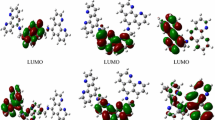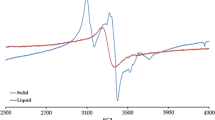Abstract
A new series of mono- and di-substituted ruthenium–polypyridine complexes of the type cis-[RuIII,II (bpy)2(L1)(L2)]n + (L1 = Cl−, bta or py; L2 = bta; bpy = 2,2′-bipyridine; bta = benzotriazole; py = pyridine) has been prepared, isolated as hexafluorophosphate salts, and investigated in organic solutions by means of cyclic voltammetry and spectroelectrochemistry. The chemical oxidation of all the benzotriazole derivatives, starting from cis-[RuII(bpy)2(L1)(bta)]x (x = +1 or +2), leads essentially to N(3)-bound products, i.e., cis-[RuIII(bpy)2 (L1)(κN(3){bta})]x+1 isomers. Nevertheless, while the benzotriazole-monosubstituted species undergoes an intramolecular isomerization, κN(3) → κN(2), accompanying the electrochemical reduction centered on the metal ion, RuIII → RuII, the disubstituted derivatives do not display any spectral or electrochemical evidence of linkage isomerism. The equilibrium and kinetic constants for the isomerization were determined from the cyclic voltammograms at several scan rates, according to an electrochemical–chemical (EC) coupling scheme. The data were compared with a set of constants and parameters obtained previously for a series of ruthenium and iron complexes. The experimental results were found to be quite consistent with theoretical calculations, and reflect the importance of π-backbonding interactions in the stabilization of the metal-centered reduced state (MII) on such species with low-spin dπ6 configuration.
Similar content being viewed by others
References
A. Werner, Ber., 40, 765 (1907).
H.E. Toma and R.C. Rocha, Croat. Chem. Acta, 74, 499 (2001).
R.C. Rocha and H.E. Toma, Can. J. Chem., 79, 145 (2001).
R.C. Rocha and H.E. Toma, Inorg. Chem. Commun., 4, 230 (2001).
R.C. Rocha, F.N. Rein and H.E. Toma, J. Braz. Chem. Soc., 12, 234 (2001).
R.C. Rocha and H.E. Toma, Inorg. Chim. Acta, 310, 65 (2000).
R.C. Rocha, K. Araki and H.E. Toma, Inorg. Chim. Acta, 285, 197 (1999).
R.C. Rocha, K. Araki and H.E. Toma, Transition Met. Chem., 23, 13 (1998).
H.E. Toma, E. Giesbrecht and R.L.E. Rojas, J. Chem. Soc., Dalton Trans., 2469 (1985).
H.E. Toma, E. Giesbrecht and R.L.E. Rojas, Can. J. Chem., 61, 2520 (1983).
R. Walker, J. Chem. Educ., 57, 789 (1980).
R.S. Nicholson and I. Shain, Anal. Chem., 36, 706 (1964).
B.P. Sullivan, D.J. Salmon and T.J. Meyer, Inorg. Chem., 17, 3334 (1978).
B.A. Moyer and T.J. Meyer, Inorg. Chem., 20, 436 (1981).
F.N. Rein, R.C. Rocha and H.E. Toma, J. Coord. Chem., 53, 99 (2001).
H.E. Toma, R.M. Serrasqueiro, R.C. Rocha, G.J.F. Demets, H. Winnischofer, K. Araki, P.E.A. Ribeiro and C.L. Donnici, J. Photochem. Photobiol. A, 135, 185 (2000).
M. Franco, K. Araki, R.C. Rocha and H.E. Toma, J. Solution Chem., 29, 667 (2000).
R.C. Rocha, PhD thesis, Universidade de Sã o Paulo, Sã o Paulo, 2000.
V.R.L. Constantino, H.E. Toma, L.F.C. De Oliveira, F.N. Rein, R.C. Rocha and D.D. Silva, J. Chem. Soc., Dalton Trans., 1735 (1999).
B.P. Sullivan, D. Conrad and T.J. Meyer, Inorg. Chem., 24, 3640 (1985).
D.O. Silva and H.E. Toma, Can. J. Chem., 72, 1705 (1994).
H.E. Toma and A.D.P. Alexiou, Electrochim. Acta, 38, 975 (1993).
H.E. Toma and K. Araki, J. Coord. Chem., 24, 1 (1991).
H.E. Toma, P.S. Santos, M.P.D. Mattioli and L.A.A. de Oliveira, Polyhedron, 6, 603 (1987).
R.S. Nicholson, Anal. Chem., 38, 1406 (1966).
A.L. Bard and L.R. Faulkner, Electrochemical Methods: Fundamentals and Applications, 2nd edit., Wiley, New York, 2000.
A. Sevcik, Collect. Czech. Chem. Commun., 13, 349 (1948).
J.E.B. Randles, Trans. Faraday Soc., 44, 327 (1948).
J.N. Armor and H. Taube, J. Am. Chem. Soc., 92, 2560 (1970).
H. Taube, Pure Appl. Chem., 51, 901(1979).
K. Kalyanasundaram, Coord. Chem. Rev., 46, 159 (1982).
K.J. Nakamoto, J. Phys. Chem., 64, 1420 (1960).
W.W. Brandt, F.P. Dwyer and E.C. Gyarfas, Chem. Rev., 54, 959 (1954).
G.M. Bryant, J.E. Fergusson and H.K.J. Powell, Aust. J. Chem., 24, 257 (1971).
A. Juris, V. Balzani, F. Barigelletti, P. Belser and A. von Zelewsky, Coord. Chem. Rev., 84, 85 (1988).
J.N. Braddock and T.J. Meyer, Inorg. Chem., 12, 723 (1973).
R.A. Krause, Inorg. Chim. Acta, 22, 209 (1977).
G.M. Bryant and J.E. Fergusson, Aust. J. Chem., 24, 275 (1971).
Author information
Authors and Affiliations
Rights and permissions
About this article
Cite this article
Rocha, R.C., Toma, H.E. Linkage isomerism and redox properties of ruthenium–polypyridine benzotriazole complexes. Transition Metal Chemistry 28, 43–50 (2003). https://doi.org/10.1023/A:1022510505110
Issue Date:
DOI: https://doi.org/10.1023/A:1022510505110




